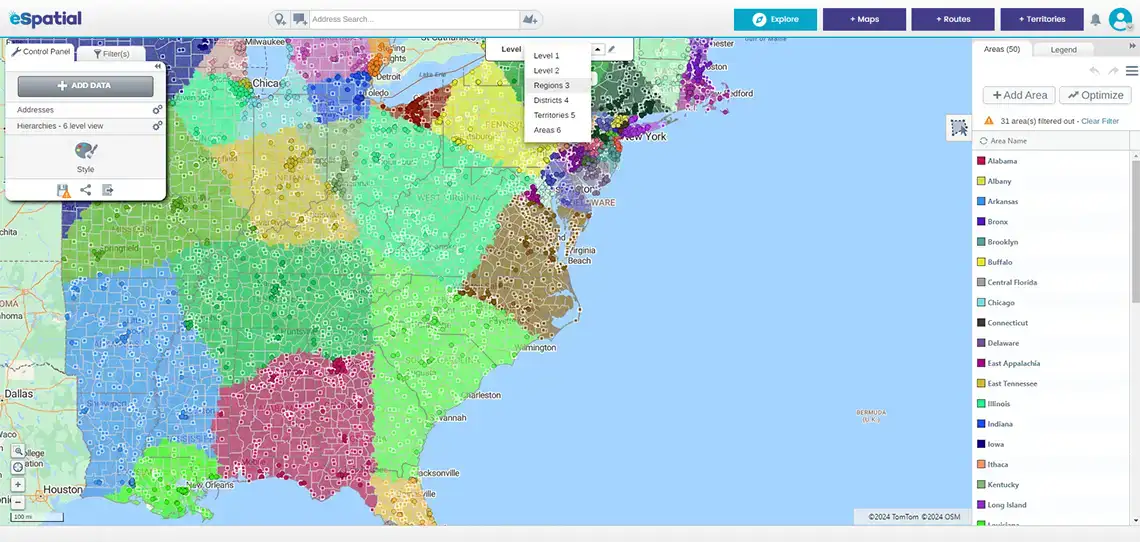Ever wondered what sets the most successful businesses apart from the competition? Well, they’ve nailed the basics. This entails investing heavily in planning, which enables their teams to better grasp the business vision, maintain operations, and drive sales.
These companies usually adopt one of two approaches to making business decisions. The two most popular and effective methods are top-down planning and bottom-up planning, often viewed as opposites. Each has benefits and shortcomings that will impact your organization, so deciding what’s most important for your business when choosing between these approaches is important.
If you're curious to learn more about these strategies, this article compares top-down vs. bottom-up sales to determine which style might better fit your organizational goals. Let’s start with top-down planning — a primary style embraced by leading companies. Then, we'll discuss bottom-up planning in more detail and see how it contributes to effective territory management.
What is top-down planning?
The top-down approach is a strategy in which the decision-making process originates from an organization’s highest levels: the C-suite, VPs, executives, directors, and managers. Typically, top-down planning begins with senior management assuming they possess superior knowledge compared to the frontline workers. As such, the leaders are tasked with crafting a comprehensive framework that incorporates objectives and strategies to drive business success, beat the competition, and maximize revenue. Then, they communicate these goals down the chain of command to ensure alignment across all teams and departments.
It's also worth mentioning that with the top-down sales approach, the leaders don't have to devise a plan to achieve the target — that's the job of the frontline workers. While this planning strategy presents some great advantages, such as a streamlined and faster decision-making process, it has some downsides, too. Due to the limited consideration of employees’ input and opinions, top down planning can lead to lower morale or even resentment within the organization.
What is bottom-up planning?
Unlike the top-down sales approach, the decision-making process in bottom-up planning starts at an organization's lowest level. Does this mean the senior leadership doesn't play a part in it? Not exactly. They do, but they must wait for the employees to define the company's objectives and tasks so it can approve them.
Usually, every department or team sets achievable targets to reach their full potential and benefit the organization in the long run. This is based on the assumption that they understand their workflow best. Consequently, the bottom-up sales approach doesn't limit workers to abstract organizational goals they may not be capable of attaining.
This planning strategy empowers workers and their divisions, allowing them to decide how they operate, and factoring in each department's microeconomics to meet current and future demands.
The benefits of a bottom-up approach
Now that you understand top-down vs bottom-up planning, let's dive into why most businesses prefer the latter.
1. Enhance employee engagement
One of the biggest advantages of bottom-up planning is strong employee engagement. Because the process involves soliciting input and ideas from employees at various levels of the organization, it allows them to contribute to the planning process. This strategy generates numerous benefits for the organization. Employees develop a sense of ownership over the company goals and feel invested in the plan's success since they have a hand in creating it.
2. Improve adaptability
Another advantage of opting for a bottom-up approach is enhanced adaptability. When employees' input is gathered from all departments, it results in diverse perspectives and relevant ideas that workers are eager to implement. Because the organization already has buy-in from frontline workers, they are better equipped to adapt to changes quickly and effectively for a more powerful impact on the organization as a whole.
3. Increase accuracy of forecasts
The bottom-up sales approach also improves forecast accuracy. Information is collected from front-line employees, sales teams, and other operational staff with firsthand knowledge of market conditions, customer preferences, and competitive dynamics. Businesses can achieve more accurate predictions when such details are incorporated into the forecasting process.
4. Optimize resource allocation
A bottom-up sales strategy leads to more efficient and effective resource use by allowing employees to participate in decision-making. Frontline workers are undoubtedly better positioned to identify opportunities for streamlining processes because they are actively involved in business operations. This not only eliminates waste but also results in improved bottom-up sales performance.
5. Deepen customer insights
Bottom-up planning allows businesses to gain valuable customer insights in numerous ways. When employees are involved in planning, organizations can leverage their meaningful observations of customer needs, preferences, and pain points.
Workers are usually the first to notice emerging trends or changes in customer behavior. Thus, organizations can tap into their observations and experiences to stay ahead of market trends and adapt their strategies to better meet customer needs. Such a proactive approach to monitoring customer behavior can lead to more informed decision-making and a deeper understanding of customer preferences.
The role of bottom-up planning in territory management
Undoubtedly, bottom-up planning makes it much easier for businesses to benefit from territory management. In this process, sellers or teams manage various groups of customers categorized by segments, such as needs, industry, and geography.

Easily switch between different levels of the hierarchy
With sales territory planning, companies can stay organized, allocate resources properly, and distribute workloads evenly. At the same time, they can identify more sales opportunities (territories) and strategically explore them to expand their customer base.
Territory management software for businesses with eSpatial
Without a doubt, a bottom-up sales approach contributes to more effective territory management. This is achieved by leveraging frontline insights, identifying sales opportunities, optimizing resource allocation, and tailoring strategies to specific territories. And employee morale and motivation will be higher to boot.
Are you ready to integrate bottom-up planning with territory management to drive business growth and success? At eSpatial, our territory management platform offers fully customizable solutions to support your unique needs. Let's connect to discuss how our solutions can help strengthen your bottom-up approach today!
 by
by 
